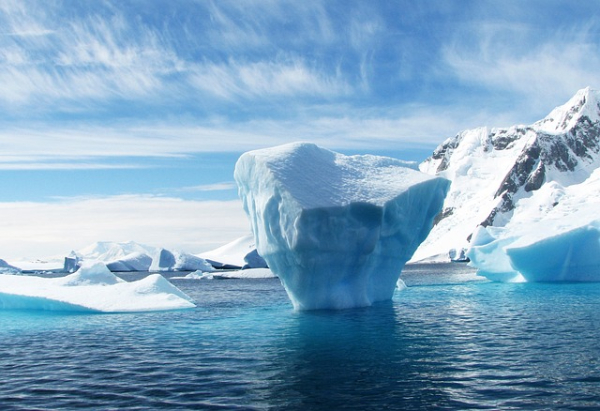As Arctic sea ice retreats during the melt season, the upper ocean warms in response to atmospheric heat fluxes. Overall, clouds reduce these fluxes in summer, but how the radiative impacts of clouds on ocean warming could change as sea ice declines has not been documented.
In global climate model simulations with variable CO2, the timing of sea ice retreat strongly influences the amplitude of cloud-induced summer cooling at the ocean surface. Under pre-industrial CO2 concentrations, summer clouds have little direct effect on maximum annual sea surface temperatures (SST). When CO2 concentrations increase, sea ice retreats earlier, allowing more solar radiation to warm the ocean. Clouds can counteract this summer warming by reflecting solar radiation back to space. Consequently, clouds explain up to 13% more variability in maximum annual SST under modern-day CO2 concentrations. Maximum annual SST are three times more sensitive to summer clouds when CO2 concentrations are four times pre-industrial levels.
Key Points
-
During the pre-industrial era, sea ice retreat timing, not clouds, primarily explains maximum annual Arctic sea surface temperatures (SST)
-
As sea ice retreats closer to the June solstice, clouds increasingly explain maximum annual SST
-
When the Arctic is seasonally ice-free, maximum SST is 3X more sensitive to clouds than in the pre-industrial era
Plain Language Summary
With higher concentrations of carbon dioxide in the atmosphere, the Arctic is warmer and has less sea ice. When sea ice melts earlier in the summer, the underlying ocean surface is exposed for longer periods of time, absorbing more energy and reaching higher temperatures. Previous studies have shown that clouds can alter the amount of energy that is absorbed at the surface, either cooling the surface by blocking incoming sunlight or warming the surface by trapping thermal energy released from the Earth. However, little work has directly linked clouds to Arctic Ocean temperatures. Using a global climate model, we investigate the relationships between clouds and ocean temperatures before and after sea ice completely melts in experiments with different carbon dioxide levels. With low levels of carbon dioxide, sea ice covers the ocean through most of the summer, and clouds have little influence on the ocean. With higher carbon dioxide levels, the ocean is free of sea ice earlier in summer when clouds have a stronger influence on how much sunlight reaches the surface. These findings suggest that when the Arctic becomes seasonally ice free, clouds will have a stronger net cooling effect on the ocean during summer.
Introduction
Arctic sea ice loss is occurring at unprecedented rates in all seasons (Stroeve & Notz, 2018), with cascading impacts on the rest of the Arctic system (Wood et al., 2015). As sea ice melts earlier in the summer over more area, larger regions of open ocean are exposed for longer periods of time (Stroeve et al., 2014). In turn, energy that would have otherwise contributed to melting sea ice can instead warm the upper ocean, leading to regions with sustained sea ice loss having the strongest ocean warming trends (Carvalho & Wang, 2020). As a result of warmer Arctic sea surface temperatures (SST), more heat is released from the ocean, delaying when ice starts growing (Serreze et al., 2009) and fueling an atmospheric response to sea ice loss (Manabe & Stouffer, 1980). Higher SST have further consequences for marine life (Divoky et al., 2021; Tsujii et al., 2021) and carbon uptake (DeGrandpre et al., 2020).
Given current Arctic sea ice decline and ocean warming, understanding Arctic SST is of increasing interest. Ocean temperatures in the Arctic are dominated by ocean heat convergence and ocean surface heat fluxes (Lique & Steele, 2013; Steele et al., 2010). The surface energy budget primarily determines heat uptake on a seasonal time scale because of the intense seasonality of Arctic solar insolation. Specifically, the earlier sea ice completely melts from a region the more incoming radiation can be absorbed by the ocean (Carmack et al., 2015). This relationship is particularly important for interior Arctic seas where vertical air-sea fluxes have a larger influence on the surface energy budget than lateral advection (Carmack & Wassmann, 2006). Steele and Dickinson (2016) showed that the timing of when sea ice completely melts strongly influences annual SST maxima in the Pacific Basin of the Arctic. In observations, the dates of when sea ice begins and then completely melts are occurring earlier, on the order of 5–10 days earlier per decade (Bliss et al., 2019; Peng et al., 2018), and Arctic oceans are already absorbing more solar radiation now than in previous decades (Sledd & L’Ecuyer, 2021). These trends are predicted to continue in coming years (Crawford et al., 2021; Lebrun et al., 2019), which will further alter the surface energy balance as the ocean continues warming (Carton et al., 2015).
Despite the known importance of clouds for the Arctic energy budget, for example, Intrieri et al. (2002), Sedlar et al. (2011), and Kay and L’Ecuyer (2013), the influence of clouds on upper ocean warming has yet to be fully explored. Clouds warm the surface by trapping and re-emitting longwave (LW) radiation and cool the surface by reflecting shortwave (SW) radiation that would otherwise be absorbed (Shupe & Intrieri, 2004). Since clouds influence the surface energy balance, and the surface energy balance impacts Arctic SST, it seems reasonable to conclude that clouds could impact SST. Previous works have focused on the influence of clouds on sea ice, for example, spring melt onset (Mortin et al., 2016) and the 2007 record minima (Kay et al., 2008), but the timing of when radiative anomalies have the largest impact on SST maxima likely differs from that for sea ice due the insulating effects of sea ice on the ocean (Perovich et al., 2007). In the few studies that have considered the influences of clouds on Arctic SST, clouds were not actually the focus, so the results were either speculative based on limited data (Minnett, 1999) or only briefly mentioned using reanalysis data (Carvalho & Wang, 2020), which have known biases for Arctic clouds, for example, Lindsay et al. (2014).
In this work we investigate the extent to which clouds influence Arctic SST annual maxima using new experiments in a state of the art coupled climate model. We first ask if clouds can affect ocean surface warming in the Arctic, and, if so, is it through warming or cooling effects? Second we ask, do the impacts of clouds on SST change with a warming climate? We use model experiments with variable CO2 concentrations to answer these questions and quantify how the sensitivity of annual SST maxima to clouds could change with rising CO2.
Discussion and Summary
A novel contribution of this work is quantifying the seasonal impacts of clouds on Arctic SST under increased CO2 concentrations. We find that under PI-forcing, clouds have little impact on SSTmax, regardless of season, because sea ice persists through summer and the underlying ocean is largely shielded from cloud radiative effects. Instead of clouds, the timing of when the ocean begins warming largely controls SSTmax, explaining 60% of its variability. This result is consistent with observations from Steele and Dickinson (2016) that the date of sea ice retreat explains the majority of SSTmax variability.
The most important finding of this study is that as sea ice melts earlier with higher CO2 levels, clouds increasingly influence SSTmax. Even with a relatively moderate increase in CO2 to present day levels, clouds are more important to SSTmax than during the pre-industrial climate. Clouds influence SSTmax during the melt season by cooling the surface and delaying the start of upper ocean warming. Where sea ice retreats earlier, clouds also explain more SSTmax variability during the heat season because the ocean warms when cloud radiative effects are most negative. In lower latitude regions that begin warming before July, cloud LWP explains 13% more SSTmax variability. When CO2 is quadrupled, the sensitivity of SSTmax to summer clouds increases by a factor of three, averaged over the whole Arctic. Overall, clouds explain 35% more SSTmax variability during the heat season than in the pre-industrial climate over the full Arctic.
In future work, observations should be used to test if the relationships between clouds and SST are currently changing in the Arctic. While reliable satellite observations of LWP are not currently available across the Arctic, cloud fraction exhibits many of the same relationships to radiative fluxes and SSTmax as LWP, and it is available. While we might expect clouds to have similar relationships to maximum annual SST as in the simulation with modern-day CO2 concentrations, future work could assess to what extent this relationship exists outside of a climate model. In particular, the Arctic may be experiencing the transition of clouds influencing SSTmax, as in the CO2-modern run, in some Arctic basins. Based on this, work we expect clouds to grow in their importance to SST as Arctic sea ice continues to decline.
Our results suggest the representation of clouds and their radiative impacts will be increasingly important for accurately modeling heat input to the upper ocean as the Arctic transitions to being seasonally ice-free. As the Arctic undergoes this transition, realistically modeling the radiative effects of clouds will likely be important not only for representing upper ocean warming but also for modeling how much heat needs to be released from the ocean to the atmosphere before sea ice can begin freezing in the fall (Deser et al., 2010; Manabe & Stouffer, 1980).
Acknowledgments
This work was supported by NASA CloudSat/CALIPSO Science Team Grants 80NSSC20K0135 (AS, TSL, JEK) and 80NSSC20K0134 (MS). MS was additionally supported by NASA Grant 80NSSC20K0768, National Science Foundation Grant OPP-1751363, and Office of Naval Research Grant N00014-17-1-2545. AS was also supported in part by NOAA cooperative agreement NA22OAR4320151. JEK was also supported by NSF AGS 1554659. We acknowledge high-performance computing support from Cheyenne (https://doi.org/10.5065/D6RX99HX) provided by NCAR's Computational and Information Systems Laboratory, sponsored by the National Science Foundation.









